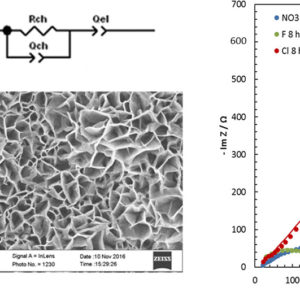Abstract
Zn–Al Layered Double Hydroxide (LDH) films were grown on aluminum substrates with different anions by a one-step, hydrothermal process at 80 °C, in which the metal substrate acts as both reactant and support. Since the films are made of partially-oriented nanoplatelets with controllable size and density, this approach can be a promising strategy for the fabrication of functionalized 3D electrodes and patterns on any surface. The presence of the different anions was confirmed by XPS measurements. Electrochemical Impedance Spectroscopy measurements were performed in order to study the electrical behavior of the films, with different inorganic anions intercalated in the LDH interlamellar space. The values of ionic conductivity are correlated to the anion type and the growth time of the films. F− intercalated LDHs present a higher conductivity than those with chloride and nitrate anions, which might be related to the lower hydration of the latter. Growth times around 8 h provided the best trade-off between shorter times, which affected the reproducibility of results, and longer periods, which induced formation of aggregates with a resulting lower conductivity
Illustrations
Details
Published on: Solid State Ionics 2018, 314, 30-35
Authors: R. Pizzoferrato, E. Ciotta, I.V. Ferrari, M. Braglia, P.G. Medaglia, A. Mattoccia, L. Di Giamberardino, M. Richetta, P. Knauth, M.L. Di Vona
